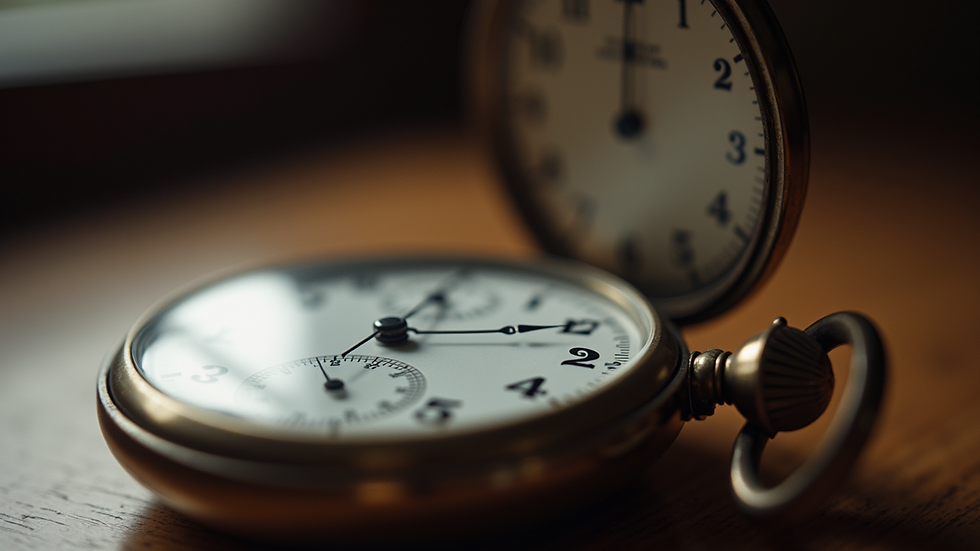How to Perfectly Wind a Pocket Watch
- Mr Andrew Howe

- Nov 3
- 3 min read
Pocket watches are timeless treasures that combine craftsmanship and history. To keep these elegant timepieces running smoothly, proper care and maintenance are essential. One of the most important aspects of maintaining a pocket watch is knowing how to wind it correctly. This guide will walk you through the steps and tips to ensure your pocket watch stays accurate and in excellent condition.
Understanding the Basics of Winding Pocket Watches
Before diving into the winding process, it’s important to understand how pocket watches work. Most traditional pocket watches are mechanical, meaning they rely on a mainspring that must be wound regularly to keep the watch ticking. Unlike modern battery-powered watches, mechanical watches need manual winding to store energy.
There are two main types of mechanical pocket watches:
Key-wound watches: These require a small key to wind the mainspring.
Stem-wound watches: These have a crown (the knob on top) that you turn to wind the watch.
Knowing which type you have will help you wind it properly and avoid damage.

Step-by-Step Guide to Winding Pocket Watches
Winding a pocket watch is a simple process, but it requires care and attention. Follow these steps to wind your watch perfectly:
Hold the watch securely: Use one hand to hold the watch firmly but gently. Avoid gripping it too tightly to prevent damage.
Locate the crown or key: If your watch is stem-wound, find the crown at the top. For key-wound watches, locate the winding key.
Turn the crown or key slowly: Rotate the crown clockwise (usually) in small, gentle turns. For key-wound watches, insert the key and turn it carefully.
Feel for resistance: As you wind, you will feel increasing resistance. Stop winding as soon as you feel the crown or key resist turning further. Overwinding can damage the mainspring.
Set the time if needed: Pull the crown gently to the time-setting position and turn it to adjust the hands.
Close the watch case: If your watch has a protective cover, close it carefully to protect the dial.
Tip: Wind your pocket watch at the same time every day to maintain consistent power and accuracy.

Common Mistakes to Avoid When Winding Pocket Watches
Even experienced collectors can make mistakes when winding their pocket watches. Here are some common pitfalls and how to avoid them:
Overwinding: Forcing the crown or key beyond resistance can break the mainspring. Always stop when you feel tension.
Winding too quickly: Rapid winding can cause internal damage. Turn the crown slowly and steadily.
Ignoring the watch type: Using a key on a stem-wound watch or vice versa can cause damage.
Not winding daily: Mechanical watches need regular winding to keep accurate time.
Winding in the wrong direction: Most watches wind clockwise, but some rare models wind counterclockwise. Check your watch’s manual or manufacturer instructions.
By avoiding these mistakes, you can extend the life of your pocket watch and keep it running smoothly.
How to Care for Your Pocket Watch Beyond Winding
Winding is just one part of pocket watch maintenance. Proper care will ensure your watch remains a cherished heirloom for years to come.
Keep it clean: Wipe the watch regularly with a soft cloth to remove dust and fingerprints.
Avoid moisture: Pocket watches are sensitive to water. Keep them dry and avoid wearing them in damp conditions.
Store properly: When not in use, store your watch in a protective case or pouch to prevent scratches.
Service regularly: Have your watch professionally serviced every 3-5 years to clean and lubricate the internal mechanisms.
Handle with care: Avoid dropping or exposing the watch to strong magnetic fields, which can affect accuracy.
These simple steps will help preserve the beauty and function of your pocket watch.
Where to Learn More About Winding a Pocket Watch
If you want to deepen your knowledge or need specific instructions for your model, there are excellent resources available online. For example, this detailed guide on winding a pocket watch offers practical advice and step-by-step instructions tailored to various types of pocket watches.
Taking the time to learn proper winding techniques and maintenance will enhance your enjoyment and appreciation of these classic timepieces.
By mastering the art of winding pocket watches, you ensure your watch remains a reliable and elegant companion. With careful handling and regular maintenance, your pocket watch can continue to tell time beautifully for generations.



Comments